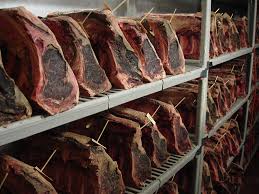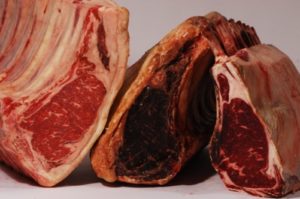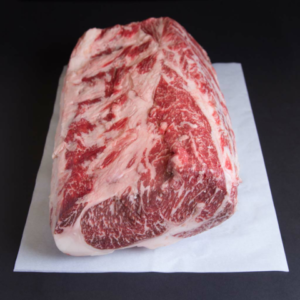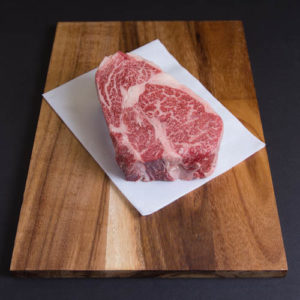DRY AGING TECHNIQUE #
Dry Aging is the management of the natural biochemical processes inherent in the postmortem muscles to maximize the tenderness and flavor development of the meat. Wagyu as a breed are inherently quite tender and extremely flavorful, further perfected by their natural diet and stress free environment. Dry Aging as a whole carcass further enhances the natural texture and deep, rich flavors to expand your gustatory satiation unique from the Wagyu breed.
DRY AGING can reflect a number of very different procedures and end products.
Individual Sub-Primal Cuts Method #
Carcass is broken down into certain typical sub-primal cuts of Rib Eye and Short Loin for further segregated aging. These cuts are enhanced by the natural processes below to develop further tenderness and flavor, but because of their exposed meat surfaces experience significant evaporation of moisture due to the same factors.
* Due to shrinkage from evaporation and other conditions, along with trimming losses from the exposed muscle, the cost can be quite extraordinary.
Whole Carcass Dry Aging #
Carcass is left in its entirety during the aging process allowing the complete natural fat and connective tissue protective covering to mitigate the effects of relative humidity, air velocity and bacterial growth. Moisture retention is also enhanced by the whole carcass method. The unique result is tender, flavor rich and juicy steaks but with equal enhancements to all the cuts across the animal including ground beef and cured products.
* The only cost is patience, watching nature doing what it does best.
THE PATH TO ENHANCED TEXTURE AND FLAVOR
After harvesting and cleaning, the complete carcass is elevated onto a rail to allow non-invasive movement as necessary through the aging time period and to fabrication.
During the first 24 hours of Rigor Mortis, anaerobic glycolysis consumes muscle glycogen producing lactates. Muscles pH is reduced from post harvest 7.4 pH, proportionally by the ambient cooler temperatures:
Temperature Slowly Lowered – ideal for slow pH reduction, better conditions for myofibril fragmentation, moisture retention thus more tender and juicy.
Temperature Quickly Lowered – cold sarcomere shortening and toughening occurs.
The calpain enzyme system begins altering cytoskeletal proteins immediately, primarily resulting in the tenderizing of the muscles over time. This important aging process is effected by the inherent pH in the muscle, ambient aging temperatures and developed nutrient values.
There are a number of inter-related conditions that effect the productive aging process:
Temperature – Ambient cooler temperature within a certain range (32 to 34) produces superior calpain enzymatic reactions for tenderness with microbial flavor enhancement.
* Too low too quickly of the aging temperature may result in toughening by “cold shortening”.
* Too cold temperatures stopping or impairing the enzymatic and microbial reactions of the aging benefits.
* Higher ambient cooler temperatures may promote bacterial growth.
* Higher ambient temperature promote “drip-loss” moisture or juice loss before and after cooking.
Relative Humidity is directly connected the the ambient environment of the micro-climate and cooler conditions.
* Low relative humidity increases dehydration while high relative humidity may promote surface bacterial growth.
Air Velocity is generally inversely proportionate to Relative Humidity.
* Higher air velocity primarily from cooler fans increases dehydration while lower air velocity may promote increased bacterial growth.
Bacterial growth is a contributing part of the aging process if controlled.
* High bacterial growth effects surface dehydration and development of “OFF” flavors.
* Ultraviolet Light can be used to retard and control bacterial growth.
Atmospheric Pressure is also directly connected to the ambient environment of the region.
* Lower atmospheric pressure at higher altitudes allows for increased surface dehydration.
* Lower atmospheric pressure may result in accelerated aging processes.
ULTIMATE FLAVOR
Aging of the muscles produces enzymatic and microbial changes producing additional free amino acids, peptides and metabolites flavor enhancers in the meat. These changes produce superior flavor and aroma characteristics, increased tenderness and juiciness.
HOW LONG
Aging time is related to all the conditions above. The Shear Force Test to identify tenderness across a 7 to 42 day period, reflect most of the aging benefits across the muscle groups occur between the 14 and 21 day period, with certain less utilized cuts experiencing tenderness improvements up to 28 days.
Flavor development tests observed similar effects over the 14 to 21 day aging period with positive taste benefits on certain cuts up to 28 days.
Testing the inherent ultimate pH level prior to fabrication insures the highest moisture retention, full flavor development and an incredibly tender steak.
ALTERNATE BEEF AGING METHODS
Wet Aging is an alternative method for aging meat that is the most popular method used in the United States today.









